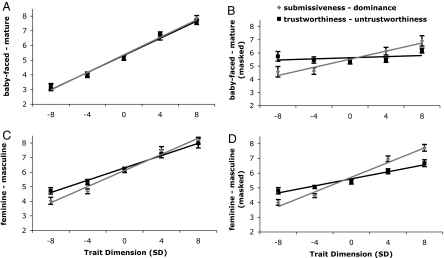Fig. 3.
Sensitivity of trustworthiness and dominance dimensions to cues related to physical strength. (A) Mean judgments of facial maturity (study 9) as a function of the trustworthiness and dominance of faces. The direction of the trustworthiness dimension was reversed to show that the slopes for the change from trustworthy to untrustworthy faces and the change from submissive to dominant faces were identical. (B) Mean judgments of facial maturity (study 10) of faces with masked internal features. The judgments were made on a 9-point scale, ranging from 1 (baby-faced) to 5 (neutral) to 9 (mature-faced). (C) Mean judgments of femininity/masculinity (study 11). (D) Mean judgments of femininity/masculinity (study 12) of faces with masked internal features. The judgments were made on a 9-point scale, ranging from 1 (feminine) to 5 (neutral) to 9 (masculine). The x-axis in the figures represents the extent of face exaggeration in SD units. Error bars show standard error of the mean. The lines represent the best linear fit.

